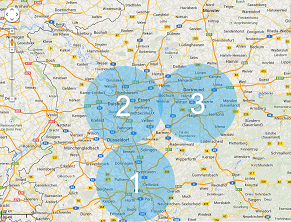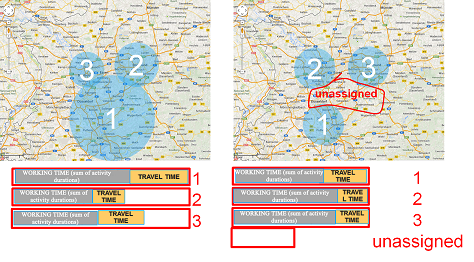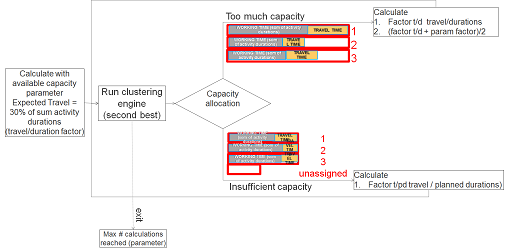Route based work load leveling and scheduling – regenerative
When the workload leveling is executed geographically, the engine calculates the length of the route, for each group.
The objective of dividing the work based on geographical area, is to divide the map first in geographical 'clusters' and later schedule or route plan within the cluster.
When the sequence of the time schedule is respected by route
planning, the Time Schedule based and Route Based planning is not applicable.
The route planning therefore continues in a 'keep sequence' mode. The distance
between the activities is calculated by the route planning routine, but the
sequence is NOT optimized to minimize the distance.
Geographical clustering of jobs
All the activities for which work must be performed are grouped together as a cluster to which the engineers are assigned.
LN, calculates the cluster, dynamically. This depends on where the work load is
(geographically ), and which determines the composition of the cluster. The planning
engine that calculates the cluster is already in use for the territory planning and
is available for group planning. In the picture on the left, represents the work
load for Wednesday and picture on the right, represents the work load for Thursday.
The engineze calculates the various geographical clusters. 
Assign to closest engineer versus work load leveling – find average available capacity for clustering engine
In the above image, the workload per group is ideally distributed over the various groups. However, the engine always tries to balance the available capacity with the minimal travel time. When capacity is infinite, the cluster engine allocates an activity to the engineer, who is closest, geographically. When sufficient capacity is not available, a number of activities remains unallocated. Both the scenarios are not the preferred solution. Therefore, the user has to manually set the allocation and influence the distribution.

When there is more capacity (picture on the left ), one group (1) may get too many activities allocated and the other groups (2,3) less. On the other hand, groups 1,2,3 can be fully booked with activities remains unassigned.

To achieve a reasonable distribution, the engine consider the
travel/duration factor. The travel time is compared to the working time (i.e.
the sum of the durations). The engine uses a group setting to allocate a
resource based on the estimated travel time. This may result in a over- or
under-capacity situation. In an 'over capacity' situation, the engine reduces
the travel duration factor using the formula (the input travel-duration ratio)
+ (resulting travel-duration ratio)/2. In an under capacity situation, the
resulting travel-duration ratio is used as the next option. You can set the Number of Iterations in Resource Planning Parameters (tsspc0101m000) session to restrict the impact on
performance. 